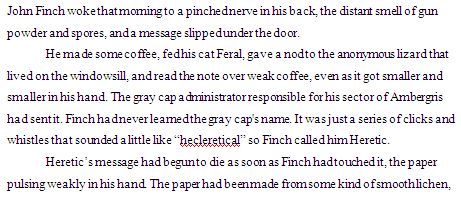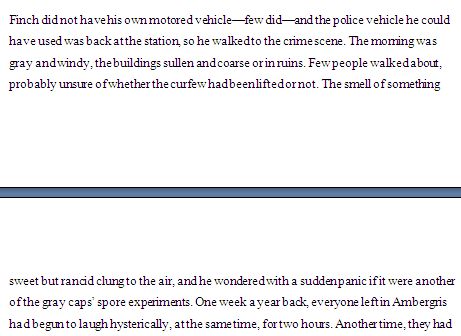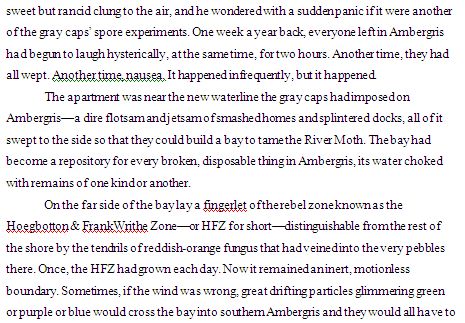Finch Novel, Opening Chapters: Discarded Approaches
(The timeline I decided not to include–without the context of events in the novel, terms like “Hoegbotton” wouldn’t have any weight.)
As per my post from Tuesday, this is the first of two follow-up entries on the opening of my novel Finch. Finch is set in my fantastical city of Ambergris, but also borrows heavily from such genres as the spy novel, the noir mystery novel, and certain types of political thrillers. In the novel, an inhuman subterranean species called gray caps has risen up to take control of the city and subjugate the human population. As in Paris during Nazi control, the gray caps attempt to give a semblance of normality by providing institutions of order like a police force, even though these institutions are often merely a façade or horrible/absurd in nature. Against this backdrop, reluctant detective John Finch must solve a strange double murder.
The discussion that follows is by no mean complete with regard to what the opening of the novel is trying to do. Nor is authorial intent always paramount, in that when readers encounter a text, the text changes. Neither am I claiming the opening of Finch is perfect. I am simply relating the process that led to the final versions of those first two chapters.
You can read the first two chapters here.
To recap, I felt I had four possible entry points to the novel:
(1) John Finch, standing over two dead bodies, at the crime scene. Beside him are his inhuman gray cap boss, Heretic, and a Partial (a kind of traitor willingly working for the gray caps).
(2) John Finch poised at the door to the apartment, inside of which are the bodies, the Partial, and Heretic.
(3) John Finch at the police station, receiving the call from Heretic about the murders, telling him to come to the apartment.
(4) John Finch in some guise giving readers an overview of the fantastical city of Ambergris in which the story takes place before being called to the crime scene.
I tried all four of these approaches, but finally settled on #2.
(An even worse iteration, from very early–Finch wakes up in the morning!)
For this post, let’s consider the options I ultimately didn’t use…
(1) John Finch, reluctant detective, standing over two dead bodies, at the crime scene. Beside him are his inhuman gray cap boss, Heretic, and a Partial (a kind of traitor willingly working for the gray caps).
In a standard noir novel, approach #1 would be a writer’s choice about eighty percent of the time. It’s immediate, it introduces the case swiftly, it creates tension automatically. Usually, you can also get in a lot of initial characterization of the detective’s cohorts. By placing the bodies in the foreground, you also emphasize the arc of the story concerning the investigation and solution of the case. However, if you are interested in creating a hybrid or mutation, or a cross-pollination of forms, the immediacy of this approach has some drawbacks; there’s such a thing as getting to a point too quickly. I abandoned this approach when it was clear I would have to pack too much information into too small a space. I also felt I would be creating the wrong emphasis, for reasons I explore below and in the third post in this series.
(3) John Finch at the police station, receiving the call from Heretic about the murders, telling him to come to the apartment.
In a police procedural with an ensemble cast, there might be a good reason for starting at the station, especially if the call about the murders happened later in the day, allowing another kind of tension to take the place of the reader’s interest in a particular case. However, starting in the station is far too early in the story for most possible story arcs. It’s the kind of approach that a beginning writer is most likely to end up with in a final draft, starting at a point that, because of the interaction between characters, seems to contain dramatic tension but is, in fact, the bridge between actions that usually gets cut–in both fiction and movies. Further, starting at the station would have created an additional demand: getting John Finch to the murder scene.
(Another alternate version, this time eschewing the car but still boring.)
In a very early draft, I started with Finch in the station and also wrote a scene of him getting into a car and driving to the murder scene. As I was writing it, I realized there was no tension in any of this, and that the car scene not only established the wrong level of technology–made things too easy–but also served as a kind of travelogue introduction to the city that actually worked against readers buying into the scenario. Still, the writing didn’t go to waste because I was able to recycle elements of the police station scene into the scenes following Finch leaving the apartment. In this context, the reader having already been introduced to the horrors of a gray cap in the flesh, the scene in the station takes on added tension in a way that it wouldn’t have if the reader hadn’t first encountered a gray cap. This is just one example of how the elements in a novel are introduced contributes heavily to reader perception of later elements.
(From later in the novel, another alternative version–Finch gets his car, finally. Still boring. Wrong level of technology.)
Note also that if I had, say, included the gray cap in an opening scene set in the station–if, for example, the gray cap hadn’t called but just appeared there–then the reader would not only be in a strange setting but meeting the main character, his colleagues, and the gray cap all at once. This would have had the effect of canceling out reader attention on important details or a necessity to downplay certain characters or elements. It’s also, I feel, a mistake in some detective novels—too many characters around a crime scene, which makes for confusing initial situations, in which the reader has to keep track of too many people. (Why an empty apartment to open? Space.)
(4) John Finch in some guise giving readers an overview of the fantastical city of Ambergris in which the story takes place before being called to the crime scene.
It is my feeling that landscape not invested with emotion or point of view is inert, lifeless. Like a historical novelist, when writing fantasy set in a place not here, I have an obligation to describe that place and make it realistic, but I have an equally important charge not to lard the narrative and the characters with excessive description or description that is not truly related to the viewpoint character. Which is to say that certain things are known to Finch and thus must be given over to the reader and other things that he knows but would not comment on or really register must be conveyed in a kind of shorthand, or conveyed in a context in which he would register them. That includes aspects of the setting, in addition to his interactions with other characters.
It’s also important to remember that characters are setting—good characterization, in which the character is clearly shaped by environment and situation, reveals a lot of information about your setting.
At the same time, I had other challenges with regard to setting (which, in Ambergris is also history). First of all, I had to strike the right balance so that readers of prior books in the series wouldn’t feel like they were being told things they already knew, and new readers would have all of the context they needed to enjoy the novel without knowing anything about Ambergris. Second, Finch is set one hundred years after the prior book in the series, Shriek: An Afterword. Therefore, it has changed in fundamental ways and I felt there needed to be a moment where the frisson of that registered with readers of my other books–and so they would have the full context of those changes.
(At least I didn’t have the problem of also having to summarize the actions of characters from the prior novel, because of the stand-alone nature of the Ambergris books—there is historical/political information the reader needs, but it’s not a narrative taking up where the last book left off. The most elegant solution in such cases is the one used by David Anthony Durham in The Other Lands—to simply include a preamble summarizing the action in the previous book, rather than try to interject unnecessary recent plot/history into the beginning of the next in the series, which bloats or slows down the new book– in a way the opposite of the potential problem with Russell’s approach to The Sparrow.)
(Yet another approach, dropped, in which while Finch is leisurely walking to the crime scene, I get in some of the description that in the final version comes at the end of chapter 2.)
In early drafts, I tried two approaches. The first was to place a timeline for Ambergris history and a two-paragraph description of the current situation as a kind of prologue. Second, I did try putting description of the city upfront. Neither approach worked at all–indeed, both approaches made me much less enthusiastic about working on the novel. Why didn’t these approaches work? The novel is about John Finch. Any attempt by me to distance the reader from Finch betrayed not only the character but the novel. It is around the time that I abandoned the city-first approach that I also abandoned the title “The Appoggiatura of John Finch” and went simply with “Finch”. So, in this way too, my early drafting didn’t go to waste. In inhabiting and discarding approaches, I came ever closer to my final approach.
(Continued in my next post, tomorrow evening.)





16 comments on “Finch Novel, Opening Chapters: Discarded Approaches”
I was gonna ask if you initially started earlier and just kept trimming and trimming and trimming until you found yourself starting with him at the threshold and found you couldn’t trim that part. This has been my experience. Same thing with endings.
I did both the trimming thing and, as noted, alternate “takes”, really.
That’s interesting re endings. My end points tend to stay the same, even if their particulars change radically. But I also don’t start putting words down until I have a clear sense of the ending. Is that your experience too?
I love this. Exploring various iterations really gives a great window into the craft of the writer. I mean, I can pick up FINCH and read a few sentences and know, immediately, that it’s just, well, right. But some of these early voices don’t even sound even sound like the same book, let alone the same writer. Sometimes restarting makes such a difference, and then stripping the layers down to the heart of it really makes it shine. Something like that, anyway.
Anyway, I’m very much enjoying this series. Can’t wait to read the next bit. :)
Gordon Van Gelder suggested I trim a page or so off the end of the The 37th Mandala, and he was right. I had built to some kind of soaring poetic finale that was all about the words, the sound of words, and sort of ignored the fact that the book had ended already, and it was more effective if the words also ended at that point. Which meant the book ended on a far grimmer note than if it had gone out with extra fancy wordage; and this was by far the right thing to do. I don’t usually start with an idea of the ending though–not at novel length. By the time I’ve gone through a draft or two, I’ll have worked it out though…and a bunch of the rewriting involves improving my aim at my desired endpoint. But it’s been a while since I’ve dealt with this…maybe I’d go about it differently now.
This is just plumb fascinating material here, Jeff. Keep these coming. It’s like a great class with a great teacher.
The most interesting aspect of this for me is how different—and more normal—the narrative voice in these drafts is compared to the final product. When did the narrative voice of the book emerge? And did it help make the decision for you re: how to start it?
Good question. I didn’t really feel like the book had a voice until the prose took on an urgency. That urgency didn’t drive how I worked on the opening so much as it did on other parts of the book. In some ways the voice made me drop whatever didn’t support it. Some scenes didn’t support the voice or the character and got chopped. It did effect how I worked my way into the novel, but that’s different than working on the opening, if you get me. Which is to say, I couldn’t get more than seventy pages into writing the novel until I had that voice/style down. The events were somewhat the same in places, but without the right voice they might as well have been totally different.
I might post, in a couple of weeks, some side-by-side of scenes that remained in the novel but were written totally differently in early drafts.
I also realize I didn’t answer correctly to Marc regarding endings. I’d forgotten that on Finch I’d originally ended with a scene between Finch and Bliss that’s earlier in the novel now. The things that happen at the novel’s end originally happened with Bliss observing with Finch. Instead, I went a little further to the point that made the most sense to my in my gut.
Thanks for the insights into what you did and didn’t do in the opening — I agree with Will and Natania that this is fascinating stuff.
I ran across my copy of Dradin the other day, so I looked at its opening after reading this post, just out of curiosity. It’s a very different book, and a very different voice, but it’s interesting to see little echoes (or coincidences) in things like the structure of the opening line, or looking in a window vs. looking in a door.
We really like this webpage. Iwish we could come here everyday\all day. Please keep on putting up much more info!
You really make it seem so easy with your presentation but I find this matter to be actually something that I think I would never understand.
It seems too complicated and very broad for me. I am looking forward for your next post, I’ll try
to get the hang of it!
My webpage; comment tricher sur dragon city
I have to thank you for the efforts you have put in penning
this blog. I’m hoping to check out the same high-grade content from you in the future
as well. In fact, your creative writing abilities has inspired me to get my own, personal site now ;)
Howdy, i read your blog occasionally and i own a similar one and i was just wondering if you get a lot of spam responses?
If so how do you prevent it, any plugin or anything you can
suggest? I get so much lately it’s driving me mad so any help is very much appreciated.
Comments are closed.